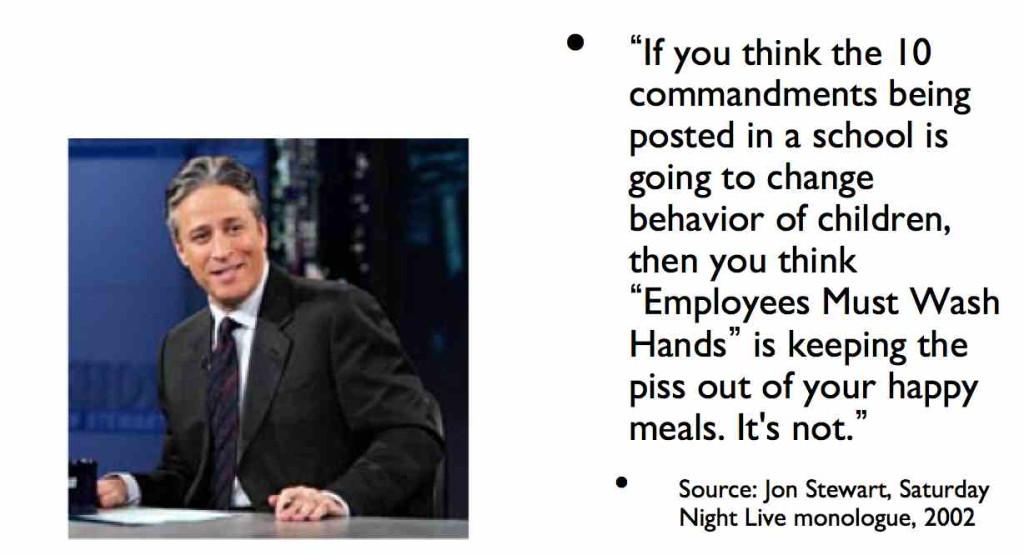We’ve written about this before, but here is another take on the effectiveness of warm or hot water in handwashing.
Researchers surveyed 510 adults and asked them questions about their hand washing behaviours and perceptions. People were asked how often they wash their hands, for  how long and how hot the water should be.
how long and how hot the water should be.
According to the published report, “70% of respondents said they believe that using hot water is more effective than warm, room temperature, or cold water, despite a lack of evidence to back that up. The research showed a, “strong cognitive connection between water temperature and hygiene in both the United States and Western Europe.”
So while many believe hot water is more effective for hand washing the study actually concluded, “the temperature of water used is not related to how well pathogens are eliminated during the process.” Additionally, warmer water can irritate the skin and can affect its protective layer, which may cause it to be less resistant to bacteria. Skin irritation has been reported as one of the main reasons many healthcare workers forgo hand hygiene for example.
Interestingly if you look at the official guidelines for hand washing from the CDC and WHO, both do not actually specify a water temperature. They do recommend using soap and water and scrubbing using proper technique for at least 20-seconds, followed by drying hands thoroughly.
Despite this there is still lots of confusion as some public health organizations still recommend, “elevated water temperature.” The FDA Food Code for example, which is a model used to enforce health standards in restaurants recommends the , “hand washing sink be equipped to provide water at a temperature of at least 100°F or 38°C.”
One subscriber to this blog recently commented, “I have come across a food safety consultant who insisted that the temperature should be 60°C (140°F). Observations revealed that staff proceeded to use cold water saying hot water was too hot! Microbiological swabbing of hands revealed an increase in Campylobacter, E.coli and Listeria counts on hands that were washed in basins when very hot water was demanded by the consultant, compared to hands exposed to water at 40 to 45 °C.”
Barry Michaels, a microbiologist and expert in infectious disease performed the only known comprehensive review of published recommendations or testing standards on hand washing and rinsing water temperatures from 1938 to 2002. He found that there was no consensus but instead temperatures ranged from ambient to “as hot as you can stand” or “as hot as possible”. Many recommendations in food and healthcare environments were not concerned with the water temperature at all, while an equal number only specified that water in the lukewarm to warm temperature regions be used. Then there was a select group including ASTM test methods, American Society of Microbiology, the FDA Food Code and experts in food and healthcare who felt that hot  water from 40 to 50 degrees °C (~100-120 degrees °F) should be used. Reasoning was that hot water was needed to melt fats in food soils and increase antimicrobial effectiveness. In testing on efficacy and skin health Barry Michaels and team found that hot water should not be used.
water from 40 to 50 degrees °C (~100-120 degrees °F) should be used. Reasoning was that hot water was needed to melt fats in food soils and increase antimicrobial effectiveness. In testing on efficacy and skin health Barry Michaels and team found that hot water should not be used.
Michaels commented, “The damage at 60°C would probably be enough to stop workers from washing hands all together. Results indicate that water temperature has only slight effect on transient or resident bacterial reduction during normal hand washing when bland soap is used. We have also tested with four other soap products each having different active ingredients (PCMX, lodophor, Quat & Triclosan) and overall, the four soap products produced similar efficacy results”.
“Although there were slight increases in Log10 reductions (ascribed to antimicrobial speed of chemical reaction), skin moisture content decreased while Visiometer skin dryness score and transepidermal water loss (TEWL) increased at higher temperatures. Results were not statistically significant for any parameter, but all trends were unmistakable.”
“In summation, water temperature should be comfortable to allow or encourage frequent hand washing with mild, but effective soaps (designed for soils to be encountered). Vigorous hand washing is the preferred method. In terms of ideal temperature, I would say from ~70 to 105 °F or ~20 to 40.5 °C. This is comfortable without the risk of skin damage,” concluded Michaels.
Reference for the research cited is: Michaels, B.; Gangar, V.; Schultz, A.; Arenas, M.; Curiale, M.; Ayers, T.; Paulson, D. Water Temperature as a Factor in Handwashing Efficacy. Food Service Technology 2002; 2:139-149.
)
 Never be anywhere without a towel.
Never be anywhere without a towel. after a handwash where pathogens may be present, and a dish towel for other things. He has a paper coming out on the topic, but is a strong believer, like me, in peer-review and publish before press release.
after a handwash where pathogens may be present, and a dish towel for other things. He has a paper coming out on the topic, but is a strong believer, like me, in peer-review and publish before press release.










